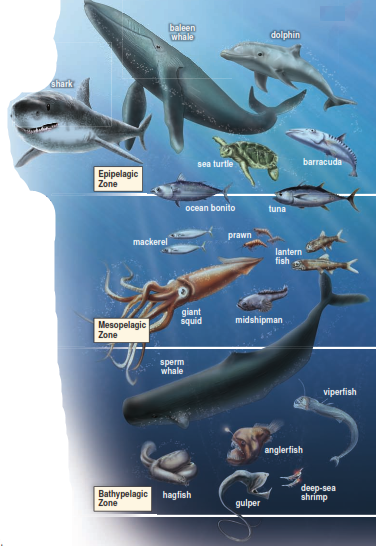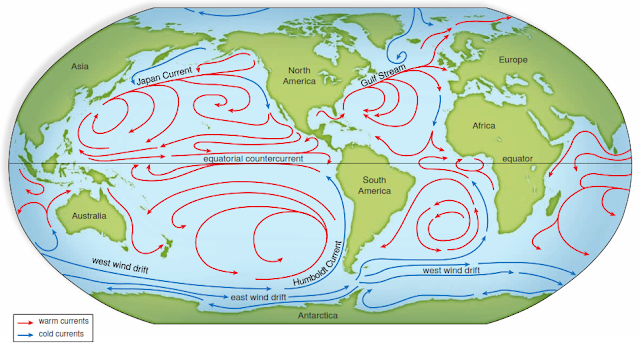Salt marshes, discussed previously, and also mudflats and mangrove swamps, featured in Figure 1, are ecosystems that occur at a delta. Mangrove swamps develop in subtropical and tropical zones, while marshes and mudflats occur in temperate zones. These ecosystems are often designated as an estuary. So are coastal bays, fjords (an inlet of water between high cliffs), and some lagoons (a body of water separated from the sea by a narrow strip of land). Therefore, the term estuary has a very broad defi nition. An estuary is a partially enclosed body of water where fresh water and seawater meet and mix as a river enters the oceans.
Organisms living in an estuary must be able to withstand constant mixing of waters and rapid changes in salinity. But those organisms adapted to the estuarine environment fi nd an abundance of nutrients. An estuary acts as a nutrient trap because the sea prevents the rapid escape of nutrients brought by a river. As the result of usually warm, calm waters and plentiful nutrients, estuaries are biologically diverse and highly productive.
Phytoplankton and shore plants thrive in the nutrient- rich estuaries, providing an abundance of food and habitat for animals. It is estimated that nearly two-thirds of marine fishes and shellfish spawn and develop in the protective and rich environment of estuaries, making the estuarine environment the nursery of the sea. An abundance of larval, juvenile, and mature fish and shellfish attract a number of predators, such as reptiles, birds, and fishes of various types.
Rocky shores (Fig. 1) and sandy shores are con- stantly bombarded by the sea as the tides roll in and out. The intertidal zone lies between the high- and low-tide marks (Fig. 2). In the upper portion of the intertidal zone, barnacles are glued so tightly to the stone by their own secretions that their calcareous outer plates remain in place, even after the enclosed shrimp like animal dies. In the midportion of the intertidal zone, brown algae, known as rockweed, may overlie the barnacles. Below the intertidal zone, macroscopic seaweeds, which are the main photosynthesizers, anchor themselves to the rocks by holdfasts.
 |
| FIGURE 2 Ocean ecosystems. Organisms live in the well-lit waters of the euphotic zone and in the increasing darkness of the deep-sea waters of the pelagic zones (see Figure 3). |
Organisms cannot attach themselves to shifting, unstable sands on a sandy beach; therefore, nearly all the permanent residents dwell underground. They either burrow during the day and surface to feed at night, or they remain permanently within their burrows and tubes. Ghost crabs and sandhoppers (amphipods) burrow themselves above the high-tide mark and feed at night when the tide is out. Sandworms and sand (ghost) shrimp remain within their burrows in the intertidal zoneand feed on detritus whenever possible. Still lower in thesand, clams, cockles, and sand dollars are found. A variety of shorebirds visit the beaches and feed on variousinvertebrates and fishes.
Oceans
Shallow ocean waters (called the euphotic zone) contain a greater concentration of organisms than the rest of the sea (see Fig. 2). Here, phytoplankton, (i.e., algae) is food not only for zooplankton (i.e., protozoans and microscopic animals) but also for small fishes. These attract a number of predatory and commercially valuable fishes. On the continental shelf, seaweed can be found growing, even on outcroppings as the water gets deeper. Clams, worms, and sea urchins are preyed upon by sea stars, lobsters, crabs, and brittle stars.
Coral reefs are areas of biological abundance just be- low the surface in shallow, warm, tropical waters. Their chief constituents are stony corals, animals that have a calcium carbonate (limestone) exoskeleton, and calcareous red and green algae. Corals provide a home for microscopic algae called zooxanthellae. The corals, which feed at night, and the algae, which photosynthesize during the day, are mutualistic and share materials and nutrients. The algae need sunlight, and this may be the reason coral reefs form only in shallow, sunlit waters.
A reef is densly populated with life. The large number of crevices and caves provide shelter for fi lter feeders (sponges, sea squirts, and fanworms) and for scavangers (crabs and sea urchins). The barracuda, moray eel, and shark are top predators in coral reefs. There are many types of small, beautifully colored fishes. These become food for larger fishes, including snappers that are caught for human consumption.
Most of the ocean lies within the pelagic zones, as noted in Figure 3. The epipelagic zone lacks the inorganic nutrients of shallow waters, and therefore it does not have as high a concentration of phytoplankton, even though the surface is sunlit. Still, the photosynthesizers are food for a large assembly of zooplankton, which then become food for schools of various fishes. A number of porpoise and dolphin species visit and feed in the epipelagic zone. Whales, too, are mammals found in this zone. Baleen whales strain krill (small crustaceans) from the water, and toothed sperm whales feed primarily on the common squid.
 |
| FIGURE 3 Ocean inhabitants of pelagic zones. Different organisms are characteristic of the epipelagic, mesopelagic, and bathypelagic zones. |
Animals in the deeper waters of the mesopelagic zone are carnivores, which are adapted to the absence of light, and tend to be translucent, red colored, or even luminescent. There are luminescent shrimps, squids, and fishes, including lantern and hatchet fishes. Various species of zooplankton, invertebrates, and fishes migrate from the mesopelagic zone to the surface to feed at night.
The deepest waters of the bathypelagic zone are in com- plete darkness except for an occasional flash of bioluminescent light. Carnivores and scavengers are found in this zone. Strange looking fishes with distensible mouths and abdomens and small, tubular eyes feed on infrequent prey.
It once was thought that few vertebrates exist on the abyssal plain beneath the bathypelagic zone because of the intense pressure and the extreme cold. Yet, many invertebrates survive there by feeding on debris floating down from the mesopelagic zone. Sea lilies (crinoids) rise above the seafloor; sea cucumbers and sea urchins crawl around on the sea bottom; and tube worms burrow in the mud.
The flat abyssal plain is interrupted by enormous underwater mountain chains called oceanic ridges. Along the axes of the ridges, crustal plates spread apart, and molten magma rises to fi ll the gap. At hydrothermal vents, seawater percolates through cracks and is heated to about 350°C, causing sulfate to react with water and form hydrogen sulfi de (H2S). Chemoautotrophic bacteria that obtain energy from oxidizing hydrogen sulfi de exist freely or mutualistically within the tissues of organisms. They are the start of food chains for an ecosystem that includes huge tube worms, clams, crustaceans, echinoderms, and fishes. This ecosystem can exist where light never penetrates because, unlike photosynthesis, chemo synthesis does not require light energy.
Ocean Currents
Climate is driven by the sun, but the oceans play a major role in redistributing heat in the biosphere. Water tends to be warm at the equator and much cooler at the poles because of the distribution of the sun’s rays, as discussed earlier. Air takes on the temperature of the water below, and warm air moves from the equator to the poles. In other words, the oceans make the winds blow. (Landmasses also play a role, but the oceans hold heat longer and remain cool longer during periods of changing temperature than do continents.)
When wind blows strongly and steadily across a great expanse of ocean for a long time, friction from the moving air begins to drag the water along with it. Once the water has been set in motion, its momentum, aided by the wind, keeps it moving in a steady flow called a current. Because the ocean currents eventually strike land, they move in a circular path— clockwise in the Northern Hemisphere and counterclockwise in the Southern Hemisphere (Fig. 4). As the currents flow, they take warm water from the equator to the poles. One such current, called the Gulf Stream, brings tropical Caribbean water to the east coast of North America and the higher latitudes of western Europe. Without the Gulf Stream, Great Britain, which has a relatively warm temperature, would be as cold as Greenland. In the Southern Hemisphere, another major ocean current warms the eastern coast of South America.
Also in the Southern Hemisphere, a current called the Humboldt Current flows toward the equator. The Humboldt Current carries phosphorus-rich cold water northward along the west coast of South America. During a process called upwelling, cold offshore winds cause cold nutrient-rich waters to rise and take the place of warm nutrient-poor waters. In South America, the enriched waters cause an abundance of marine life that supports the fisheries of Peru and northern Chile. Birds feeding on these organisms deposit their droppings on land, where they are mined as guano, a commercial source of phosphorus. When the Humboldt Current is not as cool as usual, upwelling does not occur, stagnation results, the fisheries decline, and climate patterns change globally. This phenomenon, which is discussed in the Ecology Focus on page 885, is called an El Niño–Southern Oscillation.


